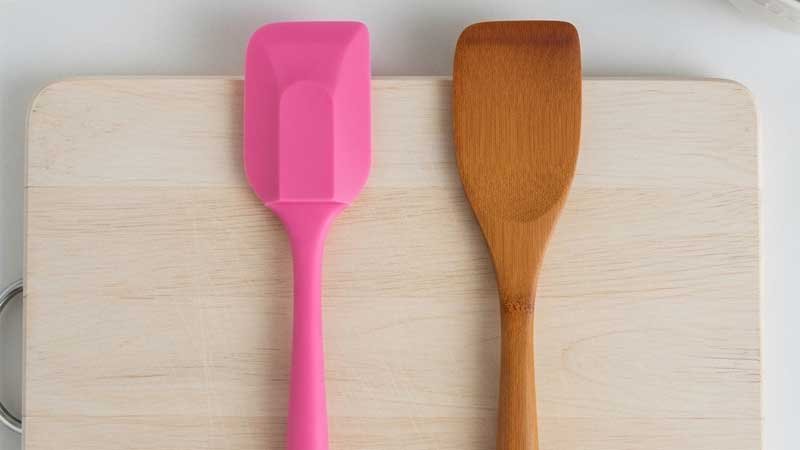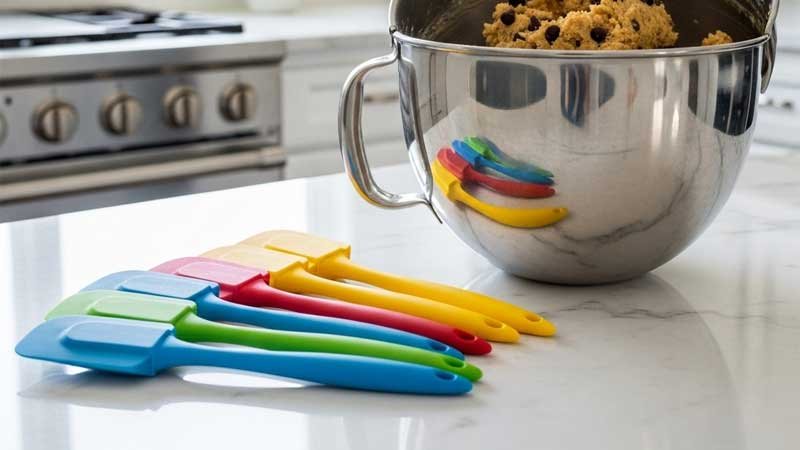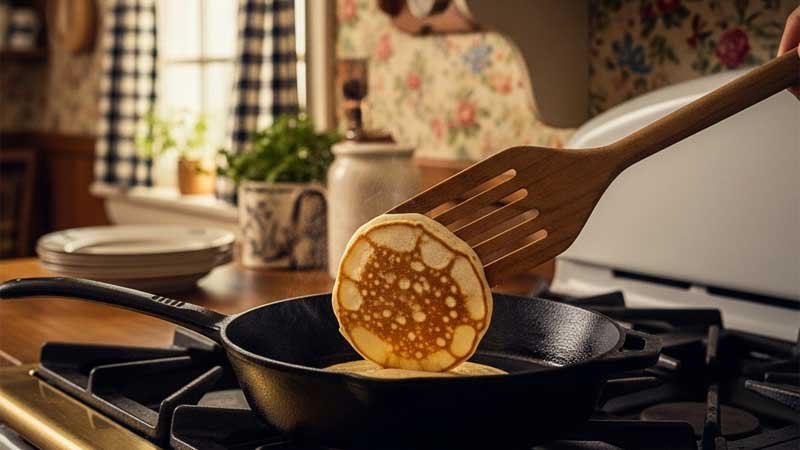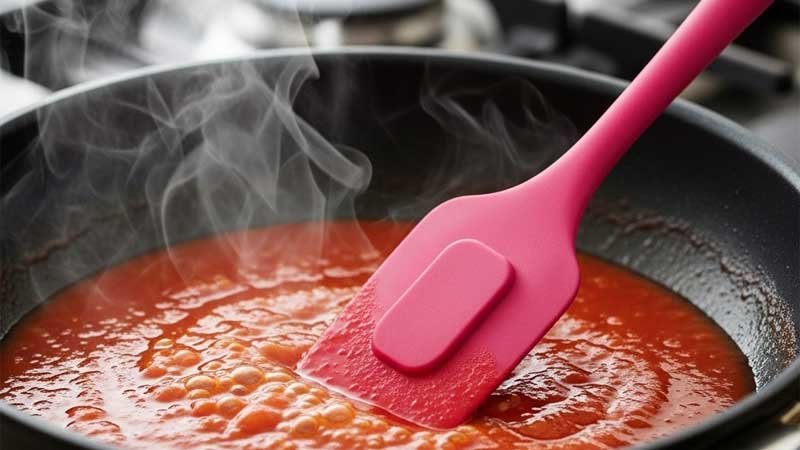In the kitchen, tradition and new ideas often meet. For a long time, wooden spatulas were common tools in many homes. But now, with better materials, silicone spatulas are becoming more popular. Why are so many people choosing silicone? What makes it better than the wooden spatulas we’ve used for years?
In this article, we’ll look at the key differences between the two. From material to daily use, we’ll show why silicone spatulas are a smart choice for modern kitchens.

Why Choose Silicone Spatulas Instead of Wooden Ones?
Silicone and wood are two very different materials. This naturally leads to big differences in how they perform in the kitchen.
Silicone: A Chemically Stable Cooking Tool
Made from strong silicon-oxygen bonds, silicone is highly stable and won’t react with food. It’s non-toxic and odor-free, helping to keep meals clean and safe.
Thanks to its excellent heat resistance, silicone handles temperatures from −40°C to 230°C with ease. Whether you’re frying, baking, or stirring hot dishes, there’s no risk of melting or releasing harmful substances.
Soft and flexible yet durable, silicone doesn’t soak up water, oil, smells, or colors. The smooth, non-porous surface helps prevent stains and makes cleaning easier. These qualities make it one of the safest materials for everyday cooking.
Wood: Natural, but with Limits
Wood is a porous material. This means it easily absorbs moisture, grease, and leftover food.
While wooden utensils can handle moderate heat, prolonged exposure may cause burning, cracking, or splintering. Over time, they wear down and become harder to clean.
Flavors and colors from strong ingredients often cling to wooden surfaces. Proper care, like oiling regularly, is needed to avoid drying out and cracking. Even then, complete cleanliness can be hard to maintain.

Which Is More Hygienic and Easier to Clean?
Kitchen hygiene matters. After all, it affects your family’s health. When it comes to keeping things clean, silicone spatulas have a clear edge.
Silicone Spatulas: A Barrier Against Bacteria
The smooth, non-stick surface of silicone leaves no place for food to hide. Cleaning is simple. You can rinse it under water or toss it into the dishwasher—either way, it comes out clean.
Because silicone doesn’t absorb water or oil, there’s no dampness for mold or bacteria to grow. This helps lower the risk of food contamination.
Even after cooking with strong-smelling foods like garlic or onions, a silicone spatula won’t hold on to odors. That means every meal stays fresh and clean.
Wooden Spatulas: A Hidden Home for Germs
Wood is naturally porous. This makes it harder to clean. Food particles often get stuck in the fibers, even after washing. This can lead to cross-contamination over time.
Moisture trapped inside the wood creates a warm, damp space—ideal for bacteria and mold. Without proper drying, a wooden spatula can quickly become unsanitary.
And after repeated use, it often holds on to strong smells and stains that are hard to remove.

Which One Lasts Longer in the Kitchen?
Durability is very important. A reliable tool not only performs well but also saves money in the long run.
Silicone Spatulas: Built to Last
Silicone is known for its flexibility and strength. It bends without breaking and bounces back to shape easily. Even with frequent use, it rarely cracks, hardens, or changes color.
Thanks to its high resistance to aging and deformation, a silicone spatula stays in good shape for years. And while the surface feels soft, it holds up well to wear and tear.
Wooden Spatulas: Natural but Needy
Wood can’t handle moisture as well. Repeated soaking and drying can cause it to warp or crack. The surface also wears down over time, sometimes forming splinters.
To stay in good condition, wooden spatulas need extra care—like oiling to keep them from drying out. As they age, hygiene concerns and surface damage often mean it’s time for a replacement.
Which Spatula Performs Better in Real Cooking?
In everyday cooking, performance and versatility can make a big difference.
Silicone Spatulas: Gentle Yet Powerful
Silicone spatulas is soft and flexible. It won’t scratch delicate surfaces like non-stick or ceramic pans. This helps your cookware last longer. The bendable edges glide smoothly along the sides of bowls and bottoms of pots, making it easy to scrape out batter, sauces, or cream without waste.
Silicone spatulas are true multitaskers. Whether you’re stirring, flipping, spreading, or smoothing, they adapt with ease. They’re also much quieter than wooden or metal tools—great for peaceful cooking.
Wooden Spatulas: Limited in Use
Wooden spatulas are firmer and may damage non-stick coatings if used roughly. Their rigid shape doesn’t fit containers as well, leaving food behind in corners.
They’re mostly good for mixing and basic stirring. But when it comes to baking or detailed tasks, they’re often less effective than silicone options.

Which Spatula Feels Better in Your Hand?
A comfortable grip can make everyday cooking easier and more enjoyable.
Silicone Spatulas: A Blend of Comfort and Smart Design
Many silicone spatulas feature one-piece construction or a silicone-wrapped handle. This makes them comfortable to grip and less likely to slip, even when wet. They’re also lightweight, so your hand won’t tire easily during long use.
With a wide range of colors, shapes, and sizes available, there’s a silicone spatula to fit every cooking style and personal taste.
Wooden Spatulas: A Natural, Warm Touch
Some people enjoy the warm, natural feel of wood. However, wooden spatulas are usually heavier than silicone ones. They also come in fewer shapes and colors, giving you less variety to choose from.
Conclusion
Based on the above comparison, silicone spatulas clearly stand out in the modern kitchen. Thanks to their excellent material stability, unmatched hygiene, long-lasting durability, and gentle touch on cookware, they offer a range of advantages that wooden spatulas simply can’t match. Not only do they improve cooking and baking efficiency, but they also help maintain better kitchen hygiene and food safety. In short, a silicone spatula is a smart investment for anyone looking to build a healthier, more efficient kitchen.
Have a product idea in mind? Let’s bring it to life in silicone. Our team is ready to turn your concept into a high-quality custom product. Start your silicone project with us—simple, fast, and reliable.